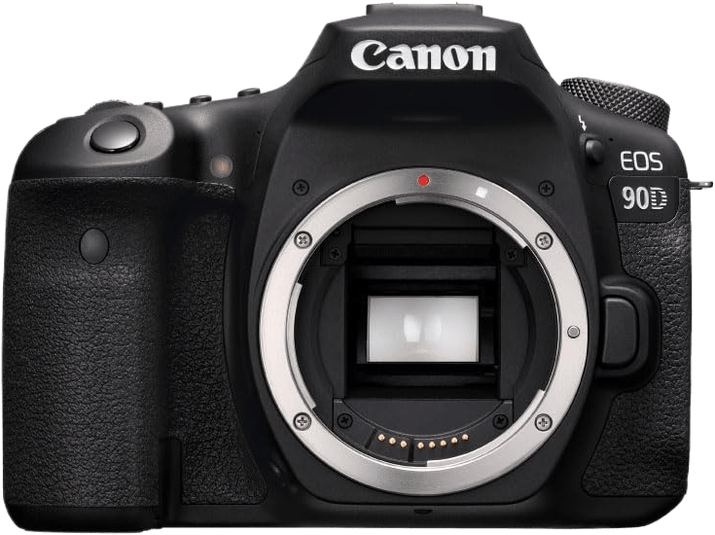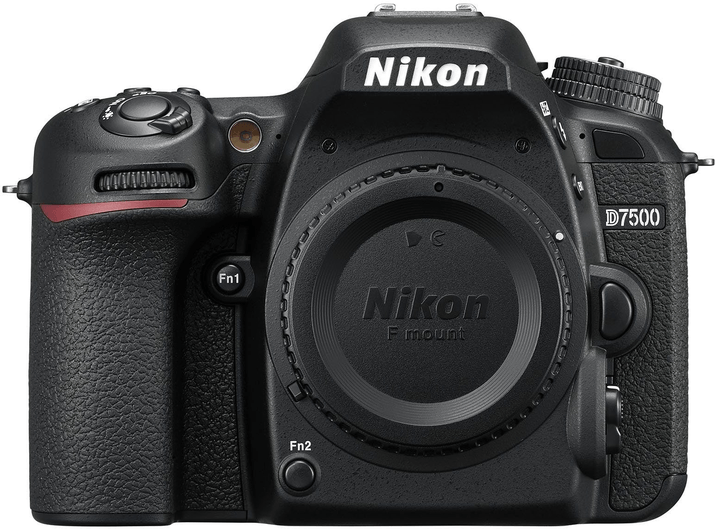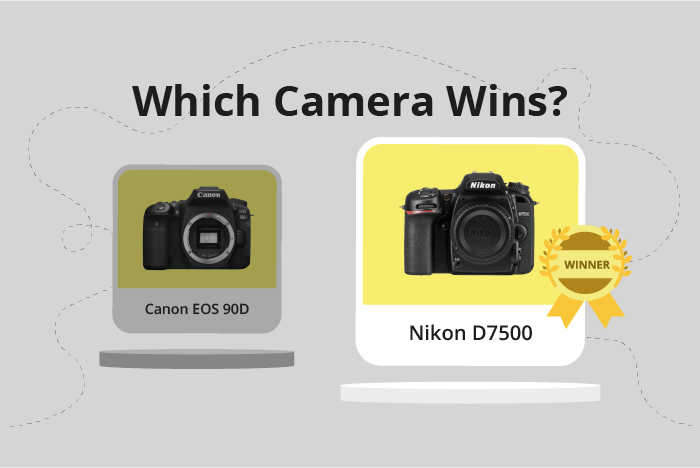Canon EOS 90D vs Nikon D7500 Comparison
Canon EOS 90D

Nikon D7500

The Nikon D7500 outperforms the Canon EOS 90D with a score of 70/100 compared to 67/100. Both cameras share similarities, including being DSLR cameras and having similar dimensions; the Canon measures 141 x 105 x 77mm, while the Nikon is 136 x 104 x 73mm. The Canon EOS 90D, released in 2019, is a newer model than the Nikon D7500, which was released in 2017. The Canon camera is also lighter at 701g compared to the Nikon’s 720g.
The Canon EOS 90D has a lower launch price of $1199 compared to the Nikon D7500’s $1250, making it more budget-friendly. However, the Nikon D7500’s higher score suggests that it offers better performance and features, justifying its slightly higher price.
When choosing between the two, consider the Canon EOS 90D for its newer release and lower price, while the Nikon D7500 is a strong contender with its better performance. Ultimately, the choice depends on individual preferences and specific photography needs.
Canon EOS 90D vs Nikon D7500 Overview and Optics
The Nikon D7500 outperforms the Canon EOS 90D in terms of optics, scoring 68 out of 100 compared to the Canon’s 62. Both cameras share several specifications, including a CMOS sensor, APS-C sensor size, and no image stabilization. However, there are key differences that contribute to the Nikon’s higher score.
The Nikon D7500 boasts a higher DXOMARK score for its sensor at 86, significantly surpassing the Canon EOS 90D’s score of 58. This indicates the Nikon’s superior image quality and low-light performance. Additionally, the Nikon utilizes an Expeed 5 processor, which contributes to faster processing and better image quality.
Despite having fewer megapixels (20.9) compared to the Canon EOS 90D’s 33, the Nikon D7500 still delivers excellent image quality. The lower megapixel count allows for better low-light performance and reduced noise. Furthermore, the Nikon D7500’s lens mount, the Nikon F DX, offers a wide range of compatible lenses, providing flexibility and options for photographers.
On the other hand, the Canon EOS 90D has a faster shooting speed of 10 frames per second, compared to the Nikon D7500’s 8. This advantage allows for capturing fast-moving subjects and action shots with greater ease. The Canon also has a higher megapixel count, which can result in higher resolution images and more detail, especially in well-lit conditions.
Taking these factors into account, the Nikon D7500 emerges as the superior camera in terms of optics, offering better image quality and low-light performance. However, the Canon EOS 90D remains a strong contender with its faster shooting speed and higher resolution, making it a suitable choice for certain photography situations.
Canon EOS 90D vs Nikon D7500 Video Performance
The Canon EOS 90D outperforms the Nikon D7500 in video capabilities with a video score of 91/100, while the Nikon D7500 scores 70/100. Both cameras have 4K max video resolution and max video dimensions of 3840 x 2160, indicating that they share similar video quality. Additionally, both cameras have built-in time-lapse functionality, which is a popular feature for videographers.
The Canon EOS 90D surpasses the Nikon D7500 in terms of video frame rate, offering a maximum of 120fps compared to the D7500’s 30fps. This difference allows the EOS 90D to capture smoother and more detailed slow-motion footage, making it the clear winner for those seeking advanced video performance.
On the other hand, the Nikon D7500 has no specific advantage over the Canon EOS 90D in terms of video capabilities. However, it is still a capable camera for capturing high-quality 4K video, and the built-in time-lapse feature adds versatility to its range of video options.
In comparing the video capabilities of the Canon EOS 90D and the Nikon D7500, the EOS 90D emerges as the superior option due to its higher video frame rate. This advantage makes the EOS 90D a more suitable choice for videographers who require advanced slow-motion capabilities. Meanwhile, the Nikon D7500 remains a decent option for those who prioritize 4K video quality and time-lapse functionality.
Canon EOS 90D vs Nikon D7500 Features and Benefits
The Canon EOS 90D and the Nikon D7500 both have a feature score of 83/100, making them evenly matched in terms of features. They share several specifications, including a touchscreen, flip screen, lack of GPS, WIFI, and Bluetooth connectivity.
The Canon EOS 90D has a screen size of 3 inches and a higher screen resolution of 1,040,000 dots compared to the Nikon D7500’s 3.2-inch screen with a resolution of 922,000 dots. This means the Canon EOS 90D’s screen provides a clearer and sharper display for users.
On the other hand, the Nikon D7500 has a slightly larger screen size at 3.2 inches, which may be preferred by some users for a more comfortable viewing experience. However, this advantage is minimal as both cameras have flip screens, making it easy to capture images and videos from various angles.
In terms of connectivity, both cameras offer WIFI and Bluetooth, allowing users to transfer files and control the camera remotely. The absence of GPS in both cameras does not affect their overall performance and is not a significant drawback for most users.
Therefore, the Canon EOS 90D and Nikon D7500 are highly competitive in their features, with the Canon EOS 90D having a slight edge due to its higher screen resolution. The Nikon D7500’s larger screen size may appeal to some users, but this advantage is minimal. Ultimately, the choice between these two cameras will depend on the individual’s preferences and needs, as both offer a strong set of features that cater to various photography and videography requirements.
Canon EOS 90D vs Nikon D7500 Storage and Battery
The Canon EOS 90D outperforms the Nikon D7500 in storage and battery, scoring 48/100 compared to the Nikon’s 43/100. Both cameras have a single memory card slot and accept SD, SDHC, and SDXC cards. However, the Canon EOS 90D is UHS-II compatible, allowing for faster data transfer rates.
A significant advantage of the Canon EOS 90D is its battery life, offering 1300 shots per charge using the LP-E6N battery. In contrast, the Nikon D7500 provides 950 shots per charge with its EN-EL15a battery. Neither camera supports USB charging.
Although the Nikon D7500 falls short in storage and battery performance, it still provides a decent battery life for most photography needs. The absence of UHS-II compatibility is a drawback but not a deal-breaker for casual users.
Considering the storage and battery aspects, the Canon EOS 90D proves to be the superior choice between the two cameras, especially for those seeking longer shooting sessions and faster data transfer capabilities. The Nikon D7500 remains a viable option for casual users who do not prioritize these features.
Alternatives to the Canon EOS 90D and Nikon D7500
Are you still undecided about which camera is right for you? Have a look at these popular comparisons that feature the Canon EOS 90D or the Nikon D7500:

